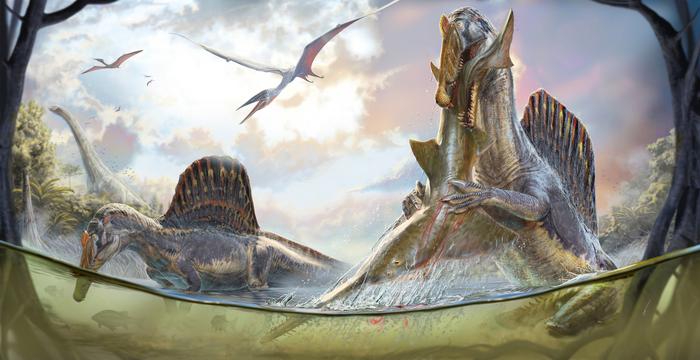The support for the hypothesis of Spinosaurus as an aquatic pursuit predator may have had fundamental flaws, according to Nathan Myhrvold of Intellectual Ventures, US and colleagues, in a study published March 6, 2024 in the open-access journal PLOS ONE.

Credit: Daniel Navarro, CC-BY 4.0 (https://creativecommons.org/licenses/by/4.0/)
The support for the hypothesis of Spinosaurus as an aquatic pursuit predator may have had fundamental flaws, according to Nathan Myhrvold of Intellectual Ventures, US and colleagues, in a study published March 6, 2024 in the open-access journal PLOS ONE.
Paleontologists generally agree that the famous Spinosaurus was a fish-eater, but exactly how these dinosaurs caught their prey is the subject of lively debate, with some researchers suggesting that they hunted on the shore, some that they waded or swam in the shallows, and others that they were aquatic pursuit predators. One recent study provided support for the latter hypothesis using a fairly new statistical method called phylogenetic flexible discriminant analysis (pFDA) to analyze density and proportions of spinosaur bones. In the present study, Myhrvold and colleagues critically assess the methods of that prior research and identify significant flaws.
This assessment identifies inconsistencies and biases in the former study’s selection of data, as well as in the definitions of certain behavioral terms. The researchers also find that this method has low accuracy when applied to the datasets used in that study due to small sample sizes and high variability of certain data. Myhrvold and colleagues believe that there are enough problems with this methodology to invalidate the findings of the previous research.
This new study does not aim to settle the debate over the lifestyle of spinosaurid dinosaurs, but it does refute the conclusions of the previous paper which supported the aquatic pursuit predator hypothesis, an idea which the authors note is also contradicted by several other studies. The authors also provide guidelines for future research, urging caution when applying pFDA to limited datasets, and highlighting limitations in the use of bone density to infer aquatic lifestyles in dinosaurs.
The authors add: “Spinosaurus, and its close relatives, are fascinating because of their unusual anatomical features, the scarcity of specimens, and the fact that scientists had not found bones from parts of its body until very recently (2020). Unlike other meat eating dinosaurs, there are strong clues that it lived near water and ate fish or other aquatic fare. This has fueled a lot of controversy about how Spinosaurus lived—was it a fast swimming predator that chased fish like a sea lion? Or was it an ambush predator at the water’s edge, grasping with its clawed hands like a giant version of a brown bear chasing salmon, or plunging its head into water like a 7-ton heron from hell? Fabbri et al. attempted to resolve the lifestyle question using statistics of bone density, but we found that the statistical method and data used are inaccurate and inappropriate.”
#####
In your coverage please use this URL to provide access to the freely available article in PLOS ONE: https://journals.plos.org/plosone/article?id=10.1371/journal.pone.0298957
Citation: Myhrvold NP, Baumgart SL, Vidal D, Fish FE, Henderson DM, Saitta ET, et al. (2024) Diving dinosaurs? Caveats on the use of bone compactness and pFDA for inferring lifestyle. PLoS ONE 19(3): e0298957. https://doi.org/10.1371/journal.pone.0298957
Author Countries: USA, Spain, Canada
Funding: The author(s) received no specific funding for this work.
Journal
PLoS ONE
DOI
10.1371/journal.pone.0298957
Method of Research
Observational study
Subject of Research
Not applicable
Article Title
Diving dinosaurs? Caveats on the use of bone compactness and pFDA for inferring lifestyle
Article Publication Date
6-Mar-2024
COI Statement
The authors have declared that no competing interests exist.




